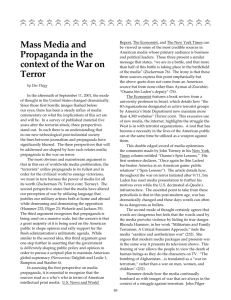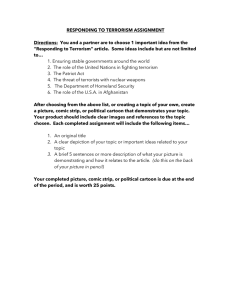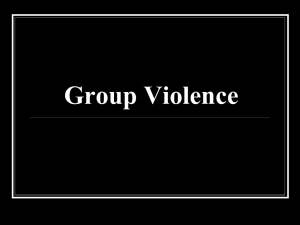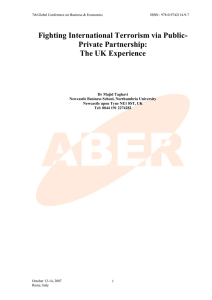An Eighth-Grade Unit Centered on 9/11
advertisement
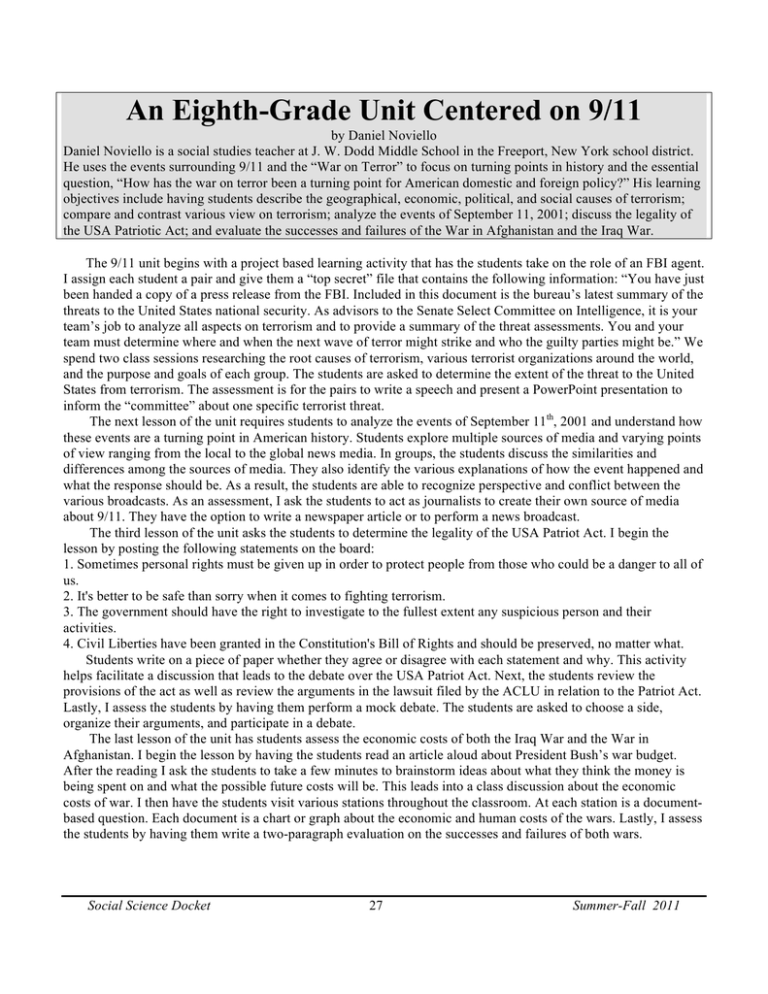
An Eighth-Grade Unit Centered on 9/11 by Daniel Noviello Daniel Noviello is a social studies teacher at J. W. Dodd Middle School in the Freeport, New York school district. He uses the events surrounding 9/11 and the “War on Terror” to focus on turning points in history and the essential question, “How has the war on terror been a turning point for American domestic and foreign policy?” His learning objectives include having students describe the geographical, economic, political, and social causes of terrorism; compare and contrast various view on terrorism; analyze the events of September 11, 2001; discuss the legality of the USA Patriotic Act; and evaluate the successes and failures of the War in Afghanistan and the Iraq War. The 9/11 unit begins with a project based learning activity that has the students take on the role of an FBI agent. I assign each student a pair and give them a “top secret” file that contains the following information: “You have just been handed a copy of a press release from the FBI. Included in this document is the bureau’s latest summary of the threats to the United States national security. As advisors to the Senate Select Committee on Intelligence, it is your team’s job to analyze all aspects on terrorism and to provide a summary of the threat assessments. You and your team must determine where and when the next wave of terror might strike and who the guilty parties might be.” We spend two class sessions researching the root causes of terrorism, various terrorist organizations around the world, and the purpose and goals of each group. The students are asked to determine the extent of the threat to the United States from terrorism. The assessment is for the pairs to write a speech and present a PowerPoint presentation to inform the “committee” about one specific terrorist threat. The next lesson of the unit requires students to analyze the events of September 11th, 2001 and understand how these events are a turning point in American history. Students explore multiple sources of media and varying points of view ranging from the local to the global news media. In groups, the students discuss the similarities and differences among the sources of media. They also identify the various explanations of how the event happened and what the response should be. As a result, the students are able to recognize perspective and conflict between the various broadcasts. As an assessment, I ask the students to act as journalists to create their own source of media about 9/11. They have the option to write a newspaper article or to perform a news broadcast. The third lesson of the unit asks the students to determine the legality of the USA Patriot Act. I begin the lesson by posting the following statements on the board: 1. Sometimes personal rights must be given up in order to protect people from those who could be a danger to all of us. 2. It's better to be safe than sorry when it comes to fighting terrorism. 3. The government should have the right to investigate to the fullest extent any suspicious person and their activities. 4. Civil Liberties have been granted in the Constitution's Bill of Rights and should be preserved, no matter what. Students write on a piece of paper whether they agree or disagree with each statement and why. This activity helps facilitate a discussion that leads to the debate over the USA Patriot Act. Next, the students review the provisions of the act as well as review the arguments in the lawsuit filed by the ACLU in relation to the Patriot Act. Lastly, I assess the students by having them perform a mock debate. The students are asked to choose a side, organize their arguments, and participate in a debate. The last lesson of the unit has students assess the economic costs of both the Iraq War and the War in Afghanistan. I begin the lesson by having the students read an article aloud about President Bush’s war budget. After the reading I ask the students to take a few minutes to brainstorm ideas about what they think the money is being spent on and what the possible future costs will be. This leads into a class discussion about the economic costs of war. I then have the students visit various stations throughout the classroom. At each station is a documentbased question. Each document is a chart or graph about the economic and human costs of the wars. Lastly, I assess the students by having them write a two-paragraph evaluation on the successes and failures of both wars. Social Science Docket 27 Summer-Fall 2011
